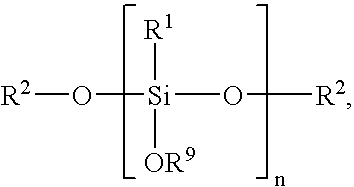Low temperature curable coating compositions and related methods
a technology of coating compositions and compositions, applied in the direction of coatings, etc., can solve the problems of large or complex articles to be coated that may not be convenient for processing through thermal or radiation cure equipment, limited flexibility, and coatings are often susceptible to chipping or thermal cracking
- Summary
- Abstract
- Description
- Claims
- Application Information
AI Technical Summary
Problems solved by technology
Method used
Image
Examples
example 1
[0098]This example illustrates the preparation of an silane functional acrylic polyol.
[0099]A reaction vessel equipped with a stirrer, thermocouple, condenser and addition funnels equipped with pumps was charged with 252.0 grams of n-butyl acetate and 2.53 grams of triphenyl phosphite and heated to reflux (about 125° C.). Two feeds, identified herein as A and B, were next gradually added to the vessel over a period of three and four hours, respectively, while the contents of the vessel were maintained at reflux conditions. Feed A consisted of a mixture of 127.0 grams styrene, 50.4 grams SILQUEST® A-174 silane (γ-methacryloxypropyltrimethoxysilane from Momentive), 144.2 grams methyl methacrylate, 101.6 grams butyl methacrylate and 83.4 grams 2-ethylhexyl methacrylate. Feed B consisted of a mixture of 30.4 grams Luperox 575 (from Atochem) and 112.0 grams n-butyl acetate. After the addition of the two feeds A and B was complete the contents of the vessel were allowed to reflux for 1 ho...
example 2
[0101]This example illustrates the preparation of a copolymer from Cardura ELOP and 1,4-cyclohexane dimethanol.
[0102]A reaction vessel equipped with stirrer, thermocouple, condenser and nitrogen inlet was charged with 187.2 grams (1.3 mole) 1,4-cyclohexane dimethanol, 936.0 grams (3.9 moles) Cardura E10P (from Hexion Specialty Chemicals) and 1.12 grams stannous octoate and heated to 130° C. The reaction exothermed to 143° C. The reaction temperature was raised to 150° C. and the contents were stirred until the epoxy equivalent weight was greater than 13,000.
[0103]The resultant product had an epoxy equivalent of 64,963, an APHA color of 80-90, a hydroxyl value of 197.3 mg KOH / g, a weight / gallon of 8.40, had a peak molecular weight of 981, a weight average molecular weight of 929 and a number average molecular weight of 714 as determined by gel permeation chromatography utilizing a polystyrene standard.
example 3
[0104]This example illustrates the preparation of a copolymer from Cardura ELOP and 1,4-cyclohexane dimethanol that contains hydrolyzable functional groups.
[0105]A reaction vessel equipped with stirrer, thermocouple, condenser and nitrogen inlet was charged with 252.3 grams (0.89 equiv.) of the product of Example 2 and 77.2 grams of n-butyl acetate and heated to 40° C. Next, 164 grams of A-Link 35 (γ-isocyanatopropyltrimethoxysilane available from Momentive Performance Materials) was gradually added to the vessel over a period of 15 minutes. The reaction temperature was raised to 60° C. and the contents were stirred for 3 hours. After this time infrared analysis indicated isocyanate was still present. The reaction temperature was increased to 85° C., an additional 22.5 grams Example 2 added. The reaction contents were stirred until the isocyanate equivalent weight was 77,588.
[0106]The resultant product had a total solids content measured for 1 hour at 110° C. of 81.1 percent by weig...
PUM
| Property | Measurement | Unit |
|---|---|---|
| Fraction | aaaaa | aaaaa |
| Percent by mass | aaaaa | aaaaa |
| Temperature | aaaaa | aaaaa |
Abstract
Description
Claims
Application Information
 Login to View More
Login to View More - R&D
- Intellectual Property
- Life Sciences
- Materials
- Tech Scout
- Unparalleled Data Quality
- Higher Quality Content
- 60% Fewer Hallucinations
Browse by: Latest US Patents, China's latest patents, Technical Efficacy Thesaurus, Application Domain, Technology Topic, Popular Technical Reports.
© 2025 PatSnap. All rights reserved.Legal|Privacy policy|Modern Slavery Act Transparency Statement|Sitemap|About US| Contact US: help@patsnap.com



